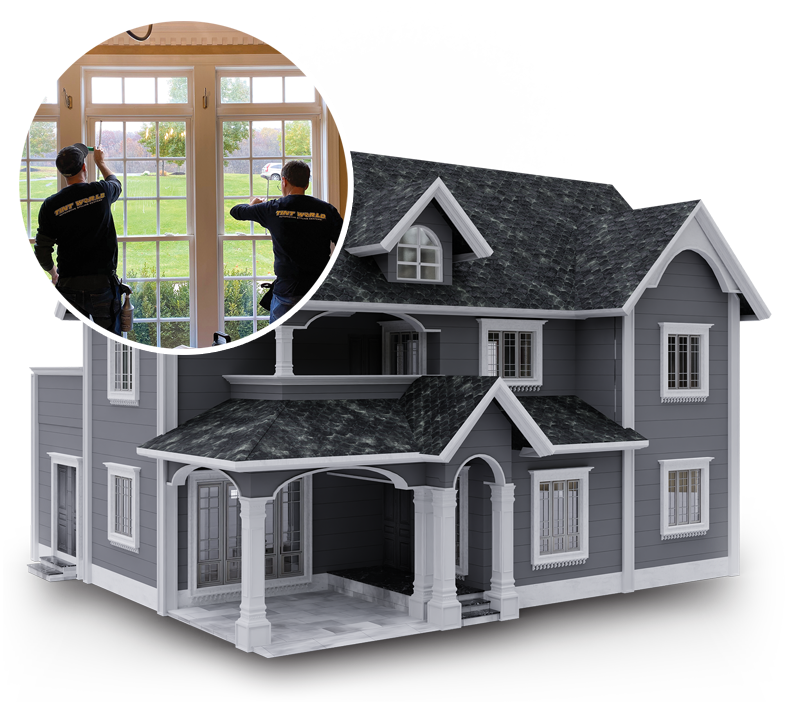Exactly How Residential Home Window Tinting Enhances Your Home's Energy Efficiency
Residential home window tinting presents an engaging service for home owners looking for to improve power efficiency within their space. By applying specialized movies to home windows, it effectively reduces heat transfer, therefore stabilizing interior temperature levels and decreasing the need for too much heating or air conditioning. This not only curtails energy usage but additionally gives a more comfy atmosphere by reducing glare. Recognizing the nuances of just how tinting jobs and picking the suitable kind for your home can be crucial. Strangely enough, what factors should one take into consideration before making this financial investment?
Comprehending Home Window Tinting
Comprehending window tinting is crucial for house owners looking for to boost both comfort and energy efficiency in their space. Residential Window Tint. Window tinting entails the application of a thin movie to the interior or outside surface area of glass windows. This movie can significantly regulate the quantity of sunshine and heat that gets in a home, therefore influencing interior climate conditions
There are numerous types of home window tinting films available, each with distinctive residential or commercial properties. The performance of window tinting is typically measured by its Visible Light Transmission (VLT) percentage, which suggests exactly how much light can pass via the film.
Advantages of Energy Performance
Window tinting not only enhances visual appeals yet additionally plays a significant role in enhancing energy efficiency within household areas. By reducing warmth transfer via windows, colored movies develop a more steady interior climate, which can lead to significant decreases in energy usage for cooling and heating. This energy efficiency converts into lower energy bills, supplying home owners with considerable long-term cost savings.

Furthermore, window tinting boosts the comfort of living rooms. By reducing glare and blocking hazardous UV rays, tinted home windows develop an even more positive environment, which can bring about enhanced health for occupants. The security versus UV rays also helps preserve furniture and floor covering from fading, adding to the long life of home items.
Exactly How Tinting Functions
Tinting films operate via a combination of sophisticated materials and modern technologies made to manage the amount of solar power getting in a home. Mostly made up of polyester, these movies often incorporate metal or ceramic bits that show and soak up warm. This double ability enables them to dramatically decrease the penetration of ultraviolet (UV) rays and infrared radiation while permitting visible light to pass through.
The efficiency of window tinting is gauged by its solar warmth gain coefficient (SHGC), which shows just how much solar power is transmitted with the window. Reduced SHGC worths are more effective as they denote higher warmth rejection. Furthermore, window colors can include a range of tones, permitting house owners to tailor their visual preferences while improving power performance.
Moreover, these films work as an obstacle, protecting against warm loss throughout colder months by showing interior heat back right into the living space. This thermal insulation result complements the cooling benefits acquired during warmer months, contributing to a well balanced interior climate year-round. By handling solar power effectively, residential window tinting not only improves go to this site convenience yet additionally plays a vital role in lowering energy intake and reducing energy expenses.
Selecting the Right Color

There are numerous kinds of window films readily available, including colored, metalized, and ceramic. Ceramic movies give excellent heat control without jeopardizing exposure and are very long lasting, making them a popular choice.
Visible light transmission (VLT) is another important factor, as it suggests the amount of all-natural light that can pass with the colored glass. House owners should select a useful link tint with a VLT that enhances their illumination preferences while still offering appropriate glow decrease.
Additionally, assessing the solar warm gain coefficient (SHGC) can aid determine exactly how well a color can block heat from sunlight. A reduced SHGC indicates far better warm control, inevitably enhancing power performance.
Setup and Maintenance Tips
Proper installation and upkeep are vital elements in taking full advantage of the benefits of residential window tinting. Experts also utilize specialized devices and techniques, which can enhance the sturdiness and performance of the tint.
Following setup, maintenance is important to prolong the life of the home window movie. It is recommended to wait at least 30 days before cleaning up the colored home windows to enable the adhesive to heal totally.
Addressing these issues immediately can stop further damages and preserve power performance. By sticking to these installation and maintenance pointers, property owners can guarantee their home window tinting continues to offer significant power financial savings and convenience for years to come.
Conclusion
In verdict, residential home window tinting offers as a reliable option for boosting power efficiency within homes. By minimizing warm transfer and blocking damaging UV rays, home window films add to lower energy consumption and improved interior convenience.
Home window tinting includes the application of a slim sites movie to the interior or exterior surface of glass windows. By minimizing warm transfer via windows, colored movies produce a much more steady interior environment, which can lead to substantial reductions in power consumption for home heating and air conditioning.The efficiency of window tinting is gauged by its solar warmth gain coefficient (SHGC), which indicates just how much solar energy is sent through the home window. By taking care of solar power efficiently, household home window tinting not only improves comfort yet additionally plays an essential role in lowering power usage and decreasing utility costs.
By lowering warmth transfer and blocking dangerous UV rays, home window movies add to reduce energy usage and enhanced interior comfort.